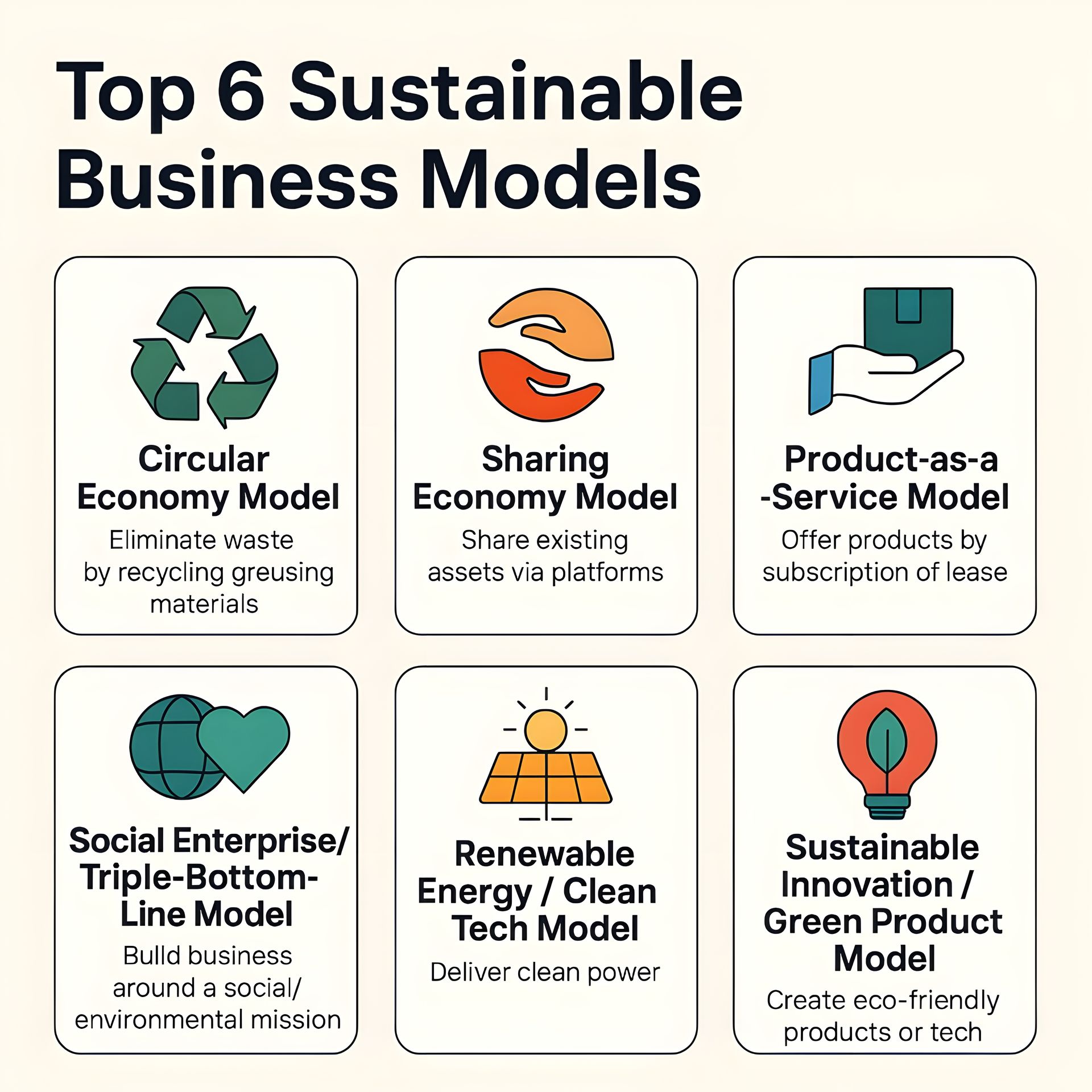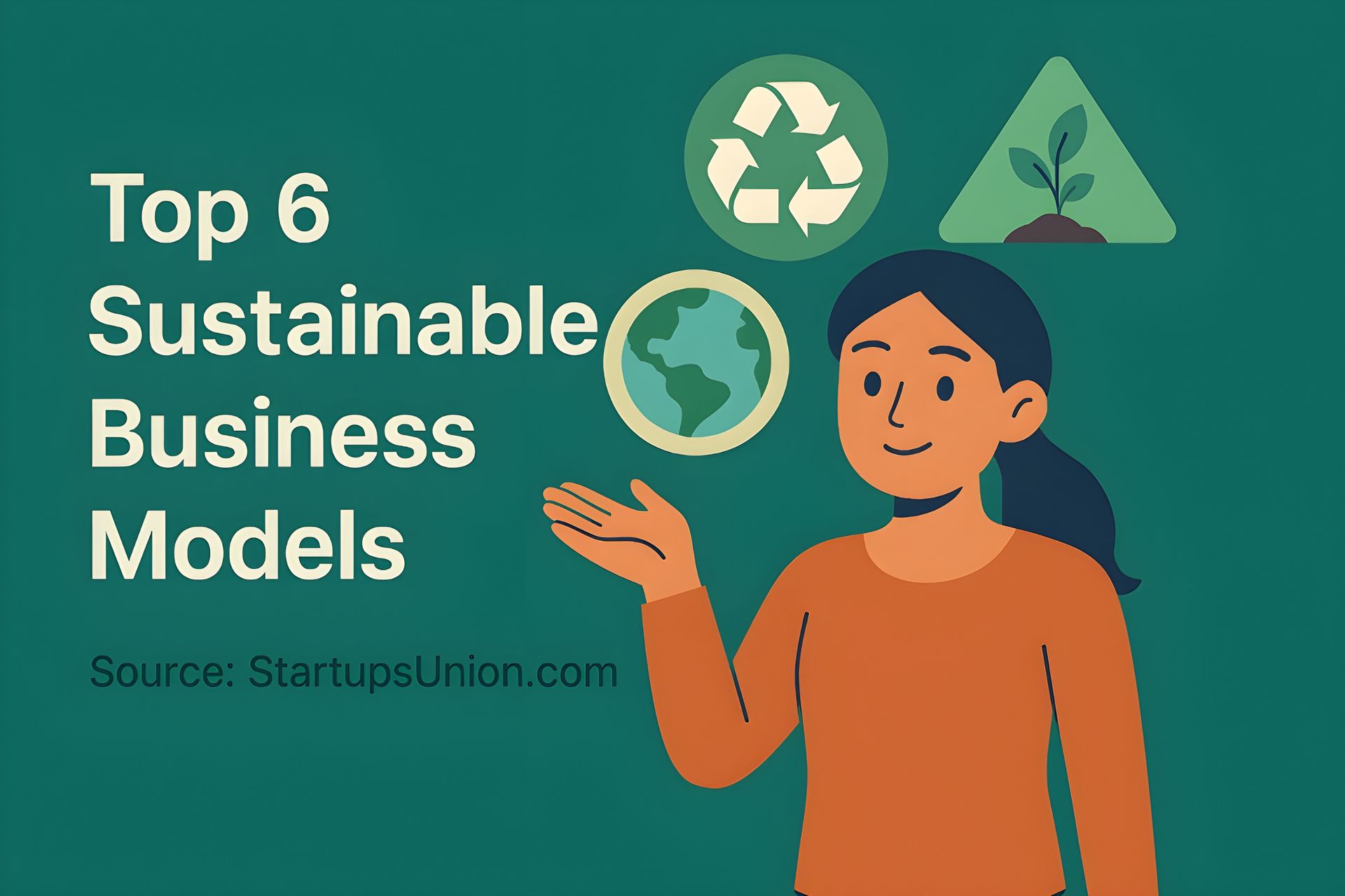"Explore Proven Business Models Driving Profit with Purpose in a Sustainable Economy"
Sustainable business models help entrepreneurs combine profit with purpose. In social entrepreneurship, businesses are often "designed around a core altruistic mission". In other words, sustainable companies align profitability with planet-friendly practices. In this post we explain six leading models - circular economy, sharing economy, product-as-a-service, social enterprise (triple bottom line), renewable energy, and eco-innovation - in clear terms. Each model includes a real-life example (with founding year and founder) to illustrate how green entrepreneurship and eco-friendly startups can succeed with sustainable innovation. These ideas are perfect profitable sustainable business ideas for young entrepreneurs, showcasing real-life examples of sustainable business practices.

1. Circular Economy Model
A circular economy model minimizes waste by designing products and systems so that materials are reused, recycled or repurposed instead of discarded. In this approach, businesses maximize efficiency and reduce environmental impact. For example, waste becomes a resource: companies may use 100% recycled inputs and create “closed-loop” supply chains. A real-world example is TerraCycle (founded 2001 by Tom Szaky and Jon Beyer), which collects difficult-to-recycle garbage (like chip bags and cigarette butts) and transforms it into raw materials for new products. TerraCycle’s success shows how a circular business can turn environmental problems into profitable opportunities.
2. Sharing Economy Model
In the sharing economy (or collaborative consumption), platforms let people share under-used assets instead of owning new ones. This model increases asset utilization and cuts costs. For instance, Airbnb (founded 2008 by Brian Chesky, Nathan Blecharczyk, and Joe Gebbia) lets homeowners rent out spare rooms or entire homes to travel. By using existing housing instead of building hotels, Airbnb provides extra income for hosts and affordable, local accommodation for guests. This green entrepreneurship model leverages what we already have and can be highly profitable for founders and users alike.
3. Product-as-a-Service Model
In a product-as-a-service model, customers subscribe to use a product rather than buying it outright. The company retains ownership and responsibility for maintenance, upgrades, and end-of-life reuse. This encourages durable design and higher product utilization. MUD Jeans (established 2012 by Bert van Son) is a great example. Customers lease a pair of denim jeans for a monthly fee; after the lease, they return the jeans for free recycling and can upgrade to a new pair. By treating clothing as a service, MUD Jeans keeps fabrics in circulation, reduces waste, and still makes a profit. Young entrepreneurs can apply this model to anything from fashion to electronics by offering rental or subscription access.
4. Social Enterprise / Triple-Bottom-Line Model
A social enterprise model embeds social or environmental goals into the core of the business. Success is measured not just by profit but by the “triple bottom line” of People, Planet, and Profit. In practice, such companies reinvest a large portion of earnings into positive impact. Patagonia, Inc. (founded 1973 by Yvon Chouinard) illustrates this well. Patagonia sells outdoor clothing made with sustainable materials and donates a percentage of its sales to environmental causes. The founder Yvon Chouinard famously built Patagonia around eco-conscious values, even pledging 1% of sales to fund green initiatives. This model shows that a business can remain profitable while actively benefiting society and the environment.
5. Renewable Energy / Clean Tech Model
Renewable energy companies focus on producing and distributing clean power to replace fossil fuels. These models often use technologies like solar panels or wind turbines and may sell energy or lease equipment. For example, SolarCity (co-founded 2006 by Lyndon and Peter Rive) pioneered residential solar energy in the US The Rive brothers built SolarCity into one of the largest solar installers, completing over 300,000 home and business installations. By leasing solar systems, they made it easier for customers to go green without high upfront costs. Entrepreneurs can adapt this model by offering solar leasing, community solar projects, or innovative clean-tech services that generate sustainable energy.
6. Sustainable Innovation / Green Product Model
Some startups center their business on eco-friendly products or groundbreaking green technologies. These companies use innovation to reduce environmental impact. Beyond Meat (founded 2009 by Ethan Brown) exemplifies this model. Brown developed plant-based “meat” that mimics animal products, tapping into a market for environmentally responsible foods. Beyond Meat’s burgers and sausages require far less land, water, and energy than traditional livestock, making them a sustainable alternative for meat lovers. This approach shows how a novel, planet-friendly product can disrupt an industry. Young entrepreneurs can apply this by creating goods from recycled materials, designing energy-efficient devices, or inventing low-waste manufacturing methods.
Key Takeaways
- Circular Economy: Eliminate waste by recycling and reusing materials (e.g. TerraCycle).
- Sharing Economy: Share existing assets via platforms (e.g. Airbnb connects hosts and guests).
- Product-as-a-Service: Offer products by subscription or lease (e.g. MUD Jeans rents jeans).
- Social Enterprise: Build business around a social/environmental mission (e.g. Patagonia donates profits to conservation).
- Renewable Energy: Deliver clean power (e.g. SolarCity installs and leases solar panels).
- Green Innovation: Create eco-friendly products or tech (e.g. Beyond Meat makes plant-based meat alternatives).
Each model above has been proven successful in the real world. By learning from these best eco-friendly startup models and their founders, young entrepreneurs can launch profitable ventures that help the planet and meet today’s market demand.
Sources: Concepts and examples are drawn from sustainability research and company histories
